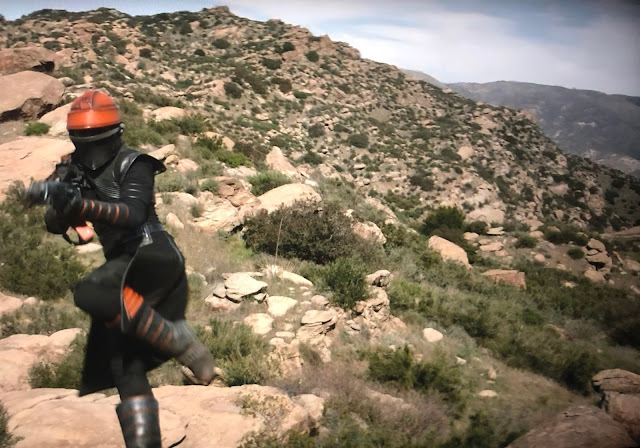The photo that rewrote Iverson Movie Ranch history
A photo surfaced recently from the depths of the incredible Bison
Archives that just about made my head explode — in a good way — as it instantly changed what we know about the early history of the Iverson
Movie Ranch.
Linda Arvidson, aka Linda Griffith, as "Everyman"
The photo is believed to be a still from the long-lost and
long-forgotten 1913 silent movie "Everyman," which stars Linda Arvidson
in the title role. That's right: Linda plays a man in the movie —
Everyman.
Linda Arvidson — One of Hollywood's earliest stars
Arvidson, also known as Linda Griffith, was married to D.W. Griffith from 1906-1936, and became one of the fledgling movie
industry's first screen stars. Linda and D.W. were separated at the time "Everyman" was produced, and the famed director was not involved with the movie.
Kinemacolor ad running in Moving Picture World, 1913
The movie was released by Kinemacolor — and the company's odd name accurately conveys its business model. Kinemacolor was a pioneer in color processing and was producing color movies more than 100 years ago.
"Two Clowns" (1908): An example of Kinemacolor's early color film process
The film version of "Everyman" was apparently lost, so we don't know what it looked like. But the above shot from the movie "Two Clowns" gives us a glimpse of the Kinemacolor process all the way back in 1908.
"Everyman": The first proof of filming on the Iverson Ranch prior to 1917
The
fact that "Everyman" can no longer be viewed intensifies the historical importance of the Bison Archives
photo, which confirms for the first time that movies were being made on the Iverson Ranch by
1913.
Karl and Augusta Iverson (1888): Founders of the Iverson Movie Ranch
I've always kind of figured that was the case, since
word-of-mouth from the Iverson family — not always a reliable source —
has consistently adhered to the story that filming began on the ranch
around 1912 or 1913.
"The Silent Man" (1917): William S. Hart and Vola Vale on the Iverson Ranch But as a historian, I need to see proof. And
until the "Everyman" photo surfaced, the earliest proof I had of filming
at Iverson went back only as far as 1917, when "
The Silent Man" and
a few other surviving films were shot.
"Everyman" (1913): Photo taken from the interior of the Garden of the Gods Taken looking north from what would later come to be known as the Garden of the Gods, the "Everyman" photo contains enough landmarks to enable us to confirm the location.
The same location in 2020
I went to the site recently to see whether it was still possible to duplicate the shot. It was harder than I expected — things had shifted around a bit since 1913 — but I came reasonably close.
Shrubbery dominates the area in 1913
I was amused to find out that the lush foliage at the bottom of the 1913 photo is still there in 2020. Not the same plants, of course, but presumably some descendants of those plants from more than a century ago.
Laurel sumac
I hear from people who know more than I do that these plants are laurel sumac, which is prominently distributed throughout much of Southern California — and is currently running rampant all over the former Iverson Ranch.
The same foliage remains in place on the Iverson Movie Ranch in 2020
A wider shot from my recent visit to the site shows that the laurel sumac also remains prominent in the part of the Garden of the Gods where the "Everyman" photo was taken. That's all laurel sumac in the foreground.
"The Adventures of Dollie" (1908): One of almost 150 D.W. Griffith-Linda Arvidson collaborations
Linda Arvidson is an unfairly overlooked figure in early Hollywood. She worked with her husband on close to 150 movies, going back to "The Adventures of Dollie" in 1908 — the first movie D.W. Griffith directed.
Early Kinemacolor projector
But by the time Griffith and Arvidson were transitioning to the West Coast, their marriage had fizzled out and they were following divergent paths. They separated in 1912, just as Griffith's star was on the rise at Biograph, and Arvidson hitched her wagon to Kinemacolor.
"The Birth of a Nation" (D.W. Griffith, 1915)
Griffith went on to become one of the most influential
filmmakers in the history of the industry, although his legacy has been tainted by his warm embrace of
the Ku Klux Klan in his 1915 opus "The Birth of a Nation."
Linda Arvidson in "The Scarlet Letter" (Kinemacolor, 1913)
Arvidson's career, meanwhile, was rapidly winding down. She appeared in just a handful of additional films before quitting acting in 1916.
"Charity" (1916): Screenplay by Linda Arvidson
Arvidson, who sometimes billed herself as Linda A. Griffith, also wrote screenplays, including "Charity," in which she also starred. Released in October 1916, the Mutual Film feature marked her final screen role.
"When the Movies Were Young," first published in 1925
It
wasn't until 1936 that Arvidson and Griffith officially divorced, when
Griffith decided to remarry. In the interim, Arvidson published a
well-regarded account of early Hollywood in her memoir, "When the Movies
Were Young."
Linda Arvidson on the Iverson Movie Ranch, no later than 1913
Because "Everyman," like the rest of Kinemacolor's output, has been lost, nailing down the origin of the photo can be tricky. But we know it's
Linda Arvidson and is a Kinemacolor photo, and Arvidson made her last
movie for Kinemacolor in 1913.
"Judith of Bethulia" (D.W. Griffith, 1914): Filmed in Chatsworth in 1912-1913
Coincidentally, around the same time Arvidson was filming on the Iverson Ranch, her estranged husband was also making movies in Chatsworth. A few miles to the south, in the Lake Manor area, D.W. Griffith was at work on "Judith of Bethulia" in 1912 and early 1913, a shoot that you can read about in
this post from 2019.







































